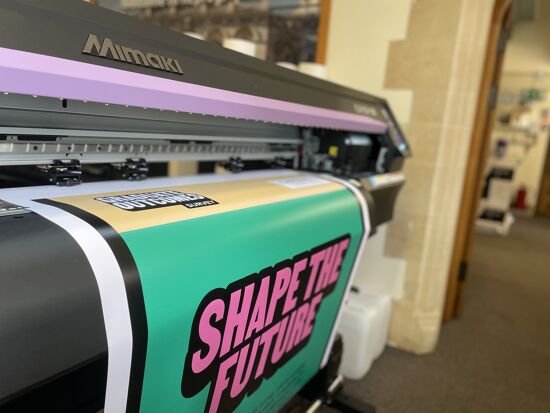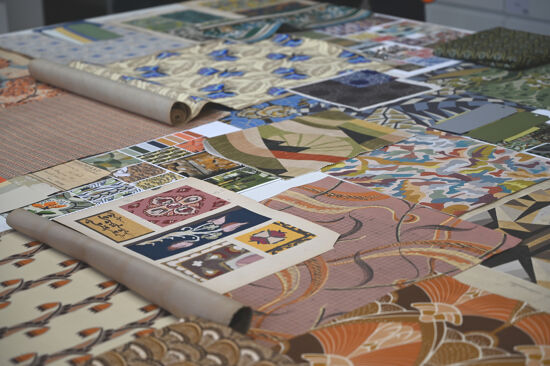The Future of AI & ML and its Impact for the Digital Manufacturing Community
.jpg?width=750)
Artificial Intelligence and its partner, Machine Learning are set to exert an enormous influence on the print Industry. Across all print disciplines, workspaces and workflows - AI and ML are about to transform our production lines into a new age neural network for smart manufacturing.
As our technologies and clients incrementally shift towards seamless, on-demand production – AI & ML are set to disrupt the manufacturing eco-system. Within a very short time frame, we will witness a sea-change for the transfer of knowledge, learning and efficiency. AI is re-wiring printed production across the entire value chain, there will be no going back to analogue, this is a one-way ticket.
The Textile Industry, currently in mid-digitisation, presents just the sort of challenge that AI & ML can resolve. Strengthening ever further the requirement and adoption of digital technologies throughout the production process and across all stakeholders. The industry currently comprises many disparate branches that need to function seamlessly, if the industry is to meet the challenges of the 21st century – the future is now, we must embrace AI & ML, adapt, and evolve.
Whether it is design, printed production, marketing or print management, AI and ML have a pivotal role to play. In this article we highlight a number of products and technologies that spotlight the depth and array of innovations evolving within our sector.
Textile & Garment Design
AI can be used to help textile designers define trends, create new patterns and apparel designs in multiple iterations, at warp speed. Digital artisans can employ prompted ML and generative AI to create intuitive, targeted design themes and customer centric garments, whilst allowing for drape or fabric construction, and product specifications in a time frame that would previously demand the labour of a large highly skilled design studio.
A recent example of this is verce, a pioneering CGI studio that creates life like virtual models and assets tailored for fashion and lifestyle. From the conception of virtual fitting models, to creating virtual fashion models and environments, verce seamlessly merges the worlds of fashion, gaming, art, CGI production, and artificial intelligence (AI) into an interdisciplinary entity.
Jaqrd.com presents an AI art generator tailored for textile fabric design, providing designers with a convenient means to create exceptional and captivating designs. Jaqrd’s AI powerful software uses advanced algorithms to produce stunning textile designs. Using cutting-edge image recognition technology - Jaqrd AI can analyse inputs and generate a unique design that incorporates a desired colour palette, pattern style, and other design elements. By weaving together, a variety of patterns, textures, and colours, these AI high-resolution designs capture every detail.
_1.jpg) Caption: “The market for artificial intelligence (AI) in vision-guided robotics (VGR) is growing rapidly, driven by the need for automation in industries such as textile manufacturing.”
Caption: “The market for artificial intelligence (AI) in vision-guided robotics (VGR) is growing rapidly, driven by the need for automation in industries such as textile manufacturing.”
Textile Colour Control and Management
With AI, textile companies can identify the ideal colour match and dye formulation for a specific product. AI-powered systems can predict colour fading, enabling businesses to make adjustments to the dye formulation, and reduce waste and costs. AI can also optimize the dyeing process, reducing water and energy consumption.
A good example is Datacolor’s SmartMatch which uses AI and machine learning to automate the dye formulation process. Traditionally, formulating a dye recipe to match a specific colour would be done visually and would usually require a number of colour correction stages along the way. With SmartMatch, the software stores and uses past experiences to produce a colour match with a lower Delta E CMC, helping to minimize colour correction steps.
Textile Production and AI Robotics
Artificial intelligence and Machine Learning (ML) can help textile manufacturers optimize production processes, increase efficiency and reduce costs. Textile mills can use AI-powered robots to automate repetitive tasks like material handling and cutting to improve precision and accuracy, leading to higher productivity. The market for artificial intelligence (AI) in vision-guided robotics (VGR) is growing rapidly, driven by the need for automation in industries such as textile manufacturing.
Fanuc uses AI-powered tools to improve accuracy, reduce programming time, and improve the overall stability of its robotic systems. They believe that AI technology can help to overcome the limitations of traditional Visual Guided Robotic systems and bring new levels of accuracy and efficiency to manufacturing operations.
Honeywell has introduced its Smart Flexible Depalletizer, which uses artificial intelligence to ease the implementation of robotic depalletizing technologies and minimize the need for manual labour to break down pallet loads. The company’s computer vision technology identifies the location of every case on the pallet, while its artificial intelligence-driven perception software automatically recognizes a variety of packaging formats. The machine learning and motion planning used in the Smart Flexible Depalletizer optimize the movements of the robotic arm to ensure maximum picking speed. The system’s control logic then senses the weight of each item as the robot lifts it and automatically updates its gripping response to transfer each product securely.
Textile mills now also use AI to analyse large amounts of data from textile production to optimize production schedules. Modern textile factories need data to be communicated seamlessly between their systems, to cut down on manual data collection, entry and analysis, and spend more time making data-driven decisions.
Smartex.ai offers integrations between their AI-Enabled, CORE quality control systems and their customers’ information systems. Through Smartex API, Smartex can now talk with their customers’ key factory software systems, such as Enterprise Resource Planning (ERP) and Manufacturing Execution Systems (MES). This facilitates a productive, two-way conversation.
.jpg) Caption: “Whether it is design, printed production, marketing or print management, AI and ML have a pivotal role to play. In this article we highlight a number of products and technologies that spotlight the depth and array of innovations evolving within our sector.”
Caption: “Whether it is design, printed production, marketing or print management, AI and ML have a pivotal role to play. In this article we highlight a number of products and technologies that spotlight the depth and array of innovations evolving within our sector.”
Textile Quality Control
AI-powered sensors, cameras, and ML algorithms in textile factories can improve the accuracy and efficiency of quality control processes. AI-powered cameras can be used to identify defects such as holes, stains, and uneven stitching, in real time, and with a high degree of accuracy. Textile companies can reduce the need for human inspection by using Artificial Intelligence and can now be implemented to bring down costs and reduce human error.
For example, the Hawk Eye system from the Durst Group, includes a scanner system, work-station and touch screen monitor. It corrects print mistakes, such as missing nozzles, inline and in real time. In the rare event of a printhead nozzle malfunctioning, in-built artificial intelligence (AI) systems automatically detect and localize any problems without any speed reduction. Neighbouring nozzles then compensate with larger drops to ensure that outstanding print quality is maintained. Operators do not need to complete any set-up and there is no need to print a special test pattern.
Resource Planning
Utilizing AI in textiles can predict demand, optimize production schedules, and manage inventory levels in real time. AI-powered systems can identify and mitigate supply chain risks, where potential issues are addressed proactively. AI not only improves efficiency and reduces costs, but it also leads to faster time-to-market, better customer service, and increased competitiveness.
Limited memory AI is being used by Netsuite to learn and streamline business processes. NetSuite Fulfilment Automation can now automate multi-location fulfilment based on warehouse proximity, ranking, or various other rules input by the user. This will streamline warehouse operations and cut customer shipping times. Harnessing the power of Artificial Intelligence to redefine business processes and elevate organizational efficiency.
AI's transformative capabilities empower businesses with intelligent automation, predictive insights, and data-driven decision-making, driving efficiency and competitiveness to new heights. NetSuite harnesses AI in its implementation process which has profound impact on businesses.
.jpg) Caption: “AI's transformative capabilities empower businesses with intelligent automation, predictive insights, and data-driven decision-making, driving efficiency and competitiveness to new heights”.
Caption: “AI's transformative capabilities empower businesses with intelligent automation, predictive insights, and data-driven decision-making, driving efficiency and competitiveness to new heights”.
Sales & Marketing
AI-powered virtual and augmented reality technology can be used to create immersive virtual showrooms. Textile companies can use this technology to showcase their products to customers in more interactive and engaging ways. Virtual reality can be used to simulate the production process, allowing textile companies to test new ideas and designs. AI-powered chatbots can provide quick and accurate responses to customer inquiries and help with online shopping.
At H&M their new AI driven chatbot can assist customers with product information and store locations, and also help with online shopping. AI algorithms are being used to monitor the social media footfalls of their users for fashion trends, brand mentions, and customer sentiment.
At aifora trend-driven, highly seasonal goods such as fashion, apparel, footwear and home, are easily configured, on the easy to use SaaS platform which offers predictive algorithms and machine learning models to interactively optimize pricing across various stages of the retail lifecycle. aifora’s solutions also enhance inventory allocation and replenishment, enabling businesses to optimize supply chains and reduce overstock or stockouts to align with sustainability initiatives.
The effect of AI and ML within the textile and printing Industry cannot be over emphasised or understated. AI meets the need for seamless, adaptive manufacturing. It harnesses data and automates complex processes to simplify the management of manufacturing.
From design through production to sales and marketing AI & ML are playing an increasingly influential role in our futures, as the benefits are leveraged to enable hyper accurate planning and control. Looking forward, this role will only increase as the software and sensors develop, allowing greater integration of AI & ML into the broad spectrum of textiles and printed production.
In our most recent podcast we interviewed Kevin Surace, and expert and futurist specialising in AI and Machine Learning.
Click here to check out the corresponding podcast for this article.
Recent news

Industry Insights, Design Trends and Disruptive Innovations for Interior Decoration
Debbie McKeegan shares key trends and innovations in the interior decoration industry taking place and demonstrated at recent European exhibitions in Germany and France. The interior decoration industry is adapting to challenges like overstock and supply chain disruptions by integrating digital and traditional methods, aiming for more agile and environmentally friendly solutions.

Bridging Design and Technology: The Story of Western Sensibility an interview with Kathryn Sanders
In this podcast episode, Debbie McKeegan interviews Kathryn Sanders, the CEO & founder of Western Sensibility, a US based company that merges interior design with digital printing technology. They discuss the origins of the business, its innovative services, and the importance of sustainability in the textile industry.

How to choose the right machine for indoor print
With interior print one of the stand-out growth areas of the industry in recent years, it is crucial printing companies select the right equipment to achieve the best quality results. Here, Rob Fletcher picks out some of the machines best suited to this work.

Resilience, Innovation and Heritage: The 100-Year Journey of the Standfast & Barracks
Renowned textile printing facility, Standfast & Barracks celebrates 100 years who are known for their expertise in rotary, flatbed and digital printing techniques. Debbie McKeegan looks at the history of the company and speaks to Lisa Montague, Managing Director about how they have adapted over the years and their future plans.